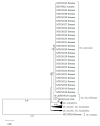Novel Mitochondrial DNA Lineage Found among Ochlerotatus communis (De Geer, 1776) of the Nordic-Baltic Region
- PMID: 32604846
- PMCID: PMC7348767
- DOI: 10.3390/insects11060397
Novel Mitochondrial DNA Lineage Found among Ochlerotatus communis (De Geer, 1776) of the Nordic-Baltic Region
Abstract
The Ochlerotatus (Oc.) communis complex consist of three Northern American species as well as a common Holarctic mosquito (Diptera: Culicidae) Oc. communis (De Geer, 1776). These sister species exhibit important ecological differences and are capable of transmitting various pathogens, but cannot always be differentiated by morphological traits. To investigate the Oc. communis complex in Europe, we compared three molecular markers (COI, ND5 and ITS2) from 54 Estonian mosquitoes as well as two COI marker sequences from Sweden. These sequences were subjected to phylogenetic analysis and screened for Wolbachia Hertig and Wolbach symbionts. Within and between groups, distances were calculated for each marker to better understand the relationships among individuals. Results demonstrate that a group of samples, extracted from adult female mosquitoes matching the morphology of Oc. communis, show a marked difference from the main species when comparing the mitochondrial markers COI and ND5. However, there is no variance between the same specimens when considering the nuclear ITS2. We conclude that Oc. communis encompasses two distinct mitochondrial DNA lineages in the Nordic-Baltic region. Further research is needed to investigate the origin and extent of these genetic differences.
Keywords: Ochlerotatus churchillensis; Ochlerotatus nevadensis; Ochlerotatus tahoensis; barcoding; phylogenetics; speciation; vectors.
Conflict of interest statement
The authors declare no conflict of interest. The funders had no role in the design of the study; in the collection, analyses, or interpretation of data; in the writing of the manuscript; or in the decision to publish the results.
Figures




Similar articles
-
Characterisation of the RNA Virome of Nine Ochlerotatus Species in Finland.Viruses. 2022 Jul 7;14(7):1489. doi: 10.3390/v14071489. Viruses. 2022. PMID: 35891469 Free PMC article.
-
Comparative Phylogeography and Integrative Taxonomy of Ochlerotatus caspius (Dipera: Culicidae) and Ochlerotatus dorsalis.J Med Entomol. 2021 Jan 12;58(1):222-240. doi: 10.1093/jme/tjaa153. J Med Entomol. 2021. PMID: 33432351
-
Deep Interisland Genetic Divergence in the Macaronesian Endemic Mosquito Ochlerotatus eatoni (Diptera: Culicidae), Indication of Cryptic Species.J Med Entomol. 2015 Sep;52(5):1175-80. doi: 10.1093/jme/tjv094. Epub 2015 Jul 12. J Med Entomol. 2015. PMID: 26336234
-
Infectivity and pathogenicity of a novel baculovirus, CuniNPV from Culex nigripalpus (Diptera: Culicidae) for thirteen species and four genera of mosquitoes.J Med Entomol. 2003 Jul;40(4):512-7. doi: 10.1603/0022-2585-40.4.512. J Med Entomol. 2003. PMID: 14680119
-
DNA barcoding mosquitoes: advice for potential prospectors.Parasitology. 2018 Apr;145(5):622-633. doi: 10.1017/S0031182018000343. Epub 2018 Mar 22. Parasitology. 2018. PMID: 29564995 Review.
References
-
- Brust R.A., Munstermann L.E. Morphological and Genetic Characterization of the Aedes (Ochlerotatus) communis Complex (Diptera: Culicidae) in North America. Ann. Entomol. Soc. Am. 1992;85:1–10. doi: 10.1093/aesa/85.1.1. - DOI
-
- Becker N., Petric D., Zgomba M., Boase C., Madon M., Dahl C., Kaiser A. Mosquitoes and Their Control. 2nd ed. Springer Science & Business Media; Heidelberg, Germany: 2010.
-
- Namin H.H., Iranpour M., Sharanowski B.J. Phylogenetics and Molecular Identification of the Ochlerotatus communis Complex (Diptera: Culicidae) Using DNA Barcoding and Polymerase Chain Reaction-Restriction Fragment Length Polymorphism. Can. Entomol. 2013;146:26–35. doi: 10.4039/tce.2013.60. - DOI
-
- Andreadis T.G., Anderson J.F., Armstrong P.M., Main A.J. Isolations of Jamestown Canyon Virus (Bunyaviridae: Orthobunyavirus) from Field-Collected Mosquitoes (Diptera: Culicidae) in Connecticut, USA: A ten-year analysis, 1997–2006. Vector-Borne Zoonotic Dis. 2008;8:175–188. doi: 10.1089/vbz.2007.0169. - DOI - PubMed
Grants and funding
LinkOut - more resources
Full Text Sources

